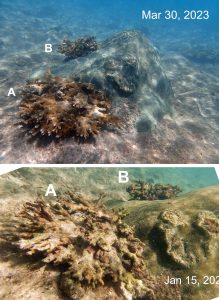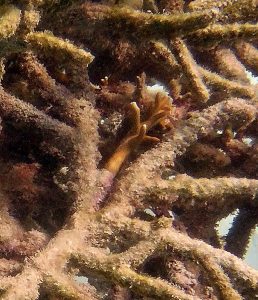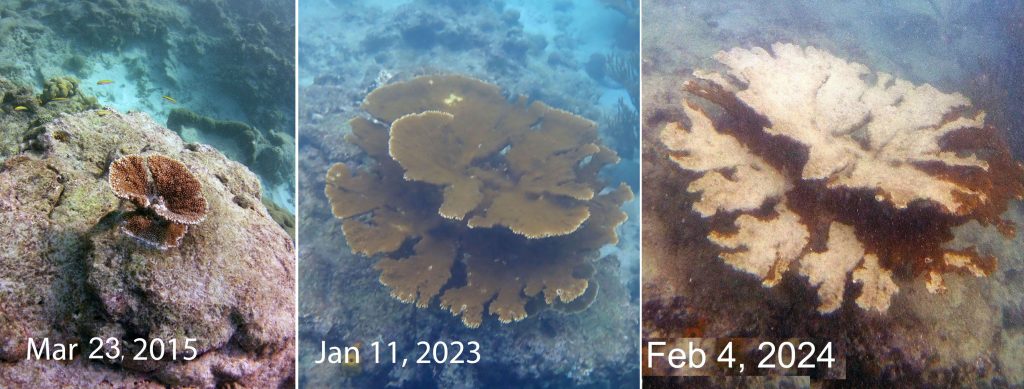
Above: Healthy A. palmata in the “Mother Colony” on April 3, 2023. Below: A palmata dead and covered with epiphytes on Jan 12, 2024
All 3 of the Caribbean Acroporoid corals occur on Vauxhall Reef – at least they did 2015 to 2023!
SCTLD (Stony Coral Tissue Loss Disease) took off on Vauxhall Reef in early 2023 but, as elsewhere, it did not attack the Acroporoid corals. I visited Vauxhall Reef for the last time in 2023 on April 3. In the fall of 2023, the whole Caribbean area including Barbados experienced extreme warming events with widespread coral bleaching. Commented Tom Goreau on Oct 14, 2023:
The entire world is suffering record high temperatures, and the Caribbean is in the forefront of global warming…The most affected species are the elkhorn, staghorn, and fire corals that build the reef crest and beaches. The event is only starting: all corals are fully bleached from loss of internal algae caused by extreme high temperature. Most are bright white, but turning brown day by day as they die and are overgrown by bacteria. Decades of progress regenerating corals have been wiped out.
Acropora prolifera: 2023 Coral Bleaching Mortality at Vauxhall Reef apparently 100%
So it was with some trepidation that on my first day on the Vauxhall Reef in 2024, Jan 12, I headed directly for the A. prolifera Mother Colony to check it out.

Above: Healthy A prolifera in the “Mother Colony” on April 3, 2023. Below A prolifera dead and covered with algae on Jan 12, 2024
My worst fear was confirmed: the entire A. prolfera component was dead and already covered with fine algae.
The sea conditions were rough on that day; on Jan 15, I checked out corals on a route from the beach, through the Reef Flat, Diploria-Palythoa, Reef Crest, Seaward Slope, & Reef Front zones: every colony of A. prolifera (in the first 3 of those zones) was dead including 15 individual colonies in the Reef Flat Zone, 4 in the Diploria-Palythoa zone, and the “mother Colony” in the Reef Crest zone. All had the same drab appearance and were heavily overgrown with epiphytes.
Over the course of my time in Barbados in 2023, I visited Vauxhall Reef 14 more times (16 in total) the last on Apr 6, 2024m and on most occasions swam over the reef flat, always on the lookout for any signs of new growth on the A. prolifera colonies. I saw none.
Acropora cervicornis: 2023 Coral Bleaching Mortality at Vauxhall Reef close to, but not 100%
Also on Jan 15, 2024, all colonies of A. cerviconis I observed in the Reef Front area appeared completely dead. Hardly good news!
Later, I observed a few living pieces of A. cervicornis on transplanted specimens that otherwise were completely dead.
Acropora palmata: 2023 Coral Bleaching Mortality at Vauxhall Reef and other MPA Fringing Reefs and Breakwaters was highly variable
It was only somewhat later that I was able to look for A. palmata colonies which are not numerous at Vauxhall.
In late January/early February, 2024, I viewed and photographed three specimens on the Vauxhall Reef, and 3 more on reefs or breakwaters just to north for which I also had photos from early 2023. The apparent, approx, mortality of these colonies in 2023 was 75%, 100% and 100% for the three Vauxhall specimens; on Mar 10, 2024 I observed a specimen in the Reef Crest, no evidence of coral bleaching.
It was 0% (no dieback) for two specimens on Reef 32 (and a 3rd, small specimen viewed later, no earlier photo was also 0%; & Mar 9, 2024, a 4th specimen entirely healthy); and 100% dieback for a specimen on a breakwater. I viewed 3 other specimens on the breakwaters but had no corresponding photos from 2023; for these specimens, one small specimen was entirely healthy; and for two there appeared to have been about 20% die- back.
In Conclusion…
So overall, it appears that A. palmata was much less affected or more variably affected by the extreme temperatures of 2023, than were A. prolifera and A. cervicornis on Vauxhall Reef & Environs; the latter experienced, evidently, 100% (A. prolifera) or close to 100% mortality (A. cervicornis) in 2023.
Some related pages on this website
– All 3 Acroporoids occur on Vauxhall Reef
– A. prolifera Mother Colony at Vauxhall
– A. palmata: effects of coral bleaching in 2023
– A. cervicornis iNaturalist Records
Dieback of natural and introduced specimens(cultured or transplanted colonies) at Vauxhall Reef in 2023 was close to 100%; a few small living branches could be seen on some transpanted specimens,
- Loss of Acropora prolifera On Vauxhall Reef (Barbados) in 2023
VIDEO posted on YouTube Feb 15, 2024
“The video shows the presumed “Mother Colony” for a set of Acropora prolifera (fused staghorn coral) colonies on the Fringing Reef at Vauxhall, Barbados on Jan 11, 2023 and Jan 15, 2024.
“The Mother Colony is a ‘complex’ of A. prolifera, Millepora sp. , and Palythoa caribaeorum covering a total area of approx 41 sq meters at the inner margin of the Reef Crest Zone (Lewis, 1960), about 1/3rd of it A. prolifera. The A. prolifera colonies are heavy set and intertwined/melded together.
“Leeward of this complex, there are 20+ individually distinct colonies extending through Lewis’s (1960) Diploria-Palythoa zone and the Reef Flat zone to close to shore. The parental species A. palmata and A. cervicornis occur on the Seaward Slope and Reef Front at Vauxhall respectively.
“On Jan 11, 2023 the A prolifera was a vibrant living entity, the branches a rich golden-brown with white tips. On Jan 15, 2024, it was entirely drab in appearance and grown over with fine algae and covered with silt like the old coral bedrock of the larger area. All other A. prolifera colonies also appeared to have died (or died back to close 100%) in 2023, likely in association with extreme warming/coral bleaching events.
“I could find no sign of any living tissue, so I assume they are entirely dead, but only time will tell.
“View more at versicolor.ca/barbados.
“The video, taken by snorkelling in a wavy area, has been slowed 50% to reduce back-and-forth motion.”
—–


